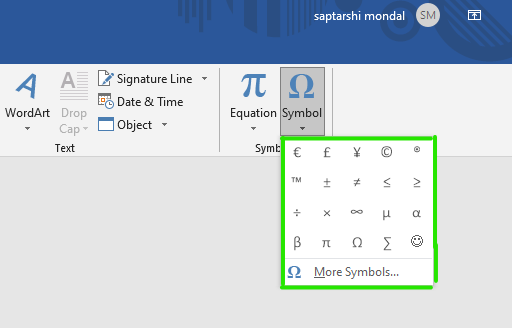Mastering Symbol Insertion in Microsoft Word: A Comprehensive Guide

Microsoft Word is not merely a tool for typing plain text; it also offers a vast array of symbols and special characters to enhance your documents. From mathematical symbols to emojis, the ability to insert symbols adds versatility and creativity to your writing. In this extensive guide, we’ll explore the intricacies of inserting symbols in Microsoft Word, equipping you with the knowledge and skills to enrich your documents with a wide range of symbols and special characters.
Understanding the Significance of Symbols:
Before delving into the practical aspects of inserting symbols, it’s essential to recognize the significance of symbols in written communication. Symbols can convey complex concepts, represent mathematical or scientific notation, add decorative elements, or express emotions and sentiments. By incorporating symbols into your documents, you can enhance clarity, engage your audience, and elevate the visual appeal of your writing.
Basic Symbol Insertion:
Inserting a symbol in Microsoft Word is a straightforward process that can be accomplished using the “Symbol” tool. Here’s how to do it:
- Navigate to the “Insert” Tab:
- Open Microsoft Word and navigate to the “Insert” tab located in the top menu bar.
- Click on “Symbol”:
- In the “Insert” tab, locate the “Symbol” button. Click on this button to reveal a dropdown menu with various symbol options.
- Choose a Symbol:
- From the dropdown menu, select “Symbol” to open the Symbol dialog box. Here, you’ll find a wide range of symbols categorized by font type.
- Select a Symbol:
- Browse through the available symbols or use the search bar to find a specific symbol. Click on the symbol you want to insert to select it.
- Insert the Symbol:
- Once you’ve selected the desired symbol, click on the “Insert” button to insert it into your document at the current cursor position.
- Close the Symbol Dialog Box:
- After inserting the symbol, you can close the Symbol dialog box by clicking on the “Close” button.
Advanced Symbol Customization:
While inserting symbols using the basic method suffices for most scenarios, Microsoft Word offers advanced customization options to tailor symbols to specific requirements. Here are some additional features you may explore:
- Symbol Shortcut Keys:
- To expedite the process of inserting commonly used symbols, Word allows users to assign shortcut keys to symbols. To set a shortcut key for a symbol, insert the symbol using the basic method, then select it and click on the “Shortcut Key” button in the Symbol dialog box. Follow the prompts to assign a shortcut key combination, and click “Assign” to confirm.
- Custom Symbol Libraries:
- In addition to the default symbol library, Word allows users to create custom symbol libraries containing frequently used symbols. To create a custom symbol library, click on the “Symbol” button in the Insert tab, then select “More Symbols.” In the Symbol dialog box, click on the “Symbols” tab, choose a font type, and click “Save As” to save the selected symbols as a custom library.
- Inserting Special Characters:
- Apart from symbols, Word offers a wide range of special characters, such as copyright symbols, em dashes, and bullet points. To insert special characters, follow the same steps as inserting symbols, but select “Special Characters” from the Symbol dialog box instead.
Best Practices for Symbol Usage:
While symbols can enhance the visual appeal and clarity of your documents, it’s essential to use them judiciously and in accordance with best practices. Here are some tips to consider:
- Maintain Consistency:
- Use symbols consistently throughout your document to maintain coherence and clarity. Choose symbols that align with the tone and style of your document and use them sparingly to avoid overwhelming the reader.
- Consider Accessibility:
- When using symbols, consider the accessibility needs of your audience. Ensure that symbols are accompanied by descriptive text or alternative representations for users with visual impairments or screen readers.
- Proofread Symbols:
- Just like text, symbols can be subject to typographical errors. Always proofread your document carefully, paying attention to the accuracy and placement of symbols.
Conclusion:
Inserting symbols in Microsoft Word is a valuable skill that empowers users to enrich their documents with a wide range of symbols and special characters. By mastering the basic insertion process, exploring advanced customization options, and adhering to best practices for symbol usage, you can effectively communicate your ideas, enhance visual appeal, and engage your audience with clarity and creativity. Whether you’re writing a report, designing a presentation, or composing a newsletter, symbols offer versatility and versatility to elevate your document’s impact. So, the next time you embark on a document creation journey in Word, remember to harness the power of symbols to add depth, meaning, and visual interest to your writing.







